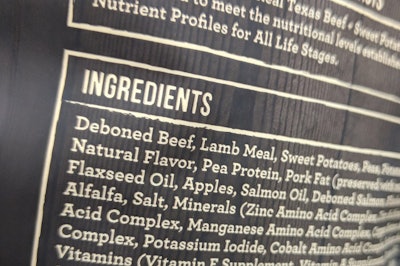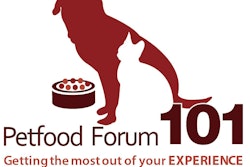
In a recent blog post by Marcel Blok, he brought forth an honest and thought-provoking concept with the current pet food trend of transparency. It is hard to debate the post when he puts it in context of simply being honest and that pet food should have nothing to hide. I think we would all agree that as an industry, we all have the best interests of pets and their owners in mind; however, the industry does tend to take a hit from time to time with product withdrawal or recalls, which occur regardless of price point and grade of materials.
The use of the word transparency isn’t being used in the context of “hey, we were lying before but now we are going to be honest.” I believe with this usage, transparency is something that the consumer is demanding and has been brought forth by consumer advocates and fearmongers (which will be discussed in my next blog post).
What is transparency?
In March 2007, the largest recall in the pet food industry occurred, which I am sure we are all familiar with. Some of the outcomes of the recall were greater transparency in who manufactures the foods and the country of origin for their ingredients. Imagine at this point in time that you are a consumer paying a premium price for your top-of-the-line superpremium product and find out it came from the same private label manufacturer using the same ingredients as a grocery store brand. This while paying over double the price.
The superpremium brand you were buying was not being dishonest about their ingredients, nutrient profiles or any other aspects of the food; nor were they were ever telling you their ingredients were better. They weren’t being dishonest; however, there was a lack of transparency that unveiled itself during the recalls, showing that pet food companies used the same manufacturer and ingredients.
This lack of transparency is still alive and well today!
If you don’t think this is ongoing today in the pet food industry for treats, wet and dry foods, then you are sadly mistaken. Unfortunately, it will take another recall to show the lack of transparency that still exists today.
I will be the first to tell you that some of the best manufacturers are indeed private label manufacturers. These manufacturers make products for many companies in the marketplace today. If this type of manufacturer does not meet specifications, then the product doesn’t enter the marketplace. It is easier for a company using a private label manufacturer to reject what is produced because it doesn’t impact their bottom line (companies do not own the inventory until they accept it). As a result, private label manufacturers generally have a higher threshold of product quality demands, whether it’s nutrient requirements, kibble size, water activity, etc., because they want to make their clients the best product and not have them reject it.
The evolution of transparency
If you have read my previous blogs, such as “Are human grade pet foods really human grade?” and the series on navigating pet product claims, then you know I believe that many companies are attempting to become transparent while some may still be misleading. The first cost of entry for any pet food company is not utilizing Chinese ingredients (consequence of the 2007 melamine recalls). If you are using vitamins, minerals or trace nutrients from this location, you are definitely at a competitive disadvantage.
Additionally, in the day and age of smartphones, no one wants to call your toll-free number to be placed on hold. The expectation is to have a statement posted on the website that simply states, “We use non-Chinese ingredients.” More importantly, the consumer wants to see the countries of origin for each ingredient. If you are getting your vitamins from Germany, then state it. If your rabbit is from France, then state it. Also, don’t make “made in the USA” claims if any of your ingredients do not come from the USA, even though you technically can by regulation, because then your company is not being completely transparent.
Also, when you make farm-to-fork type claims, you should say on your website which farm an ingredient is coming from. Although you may be honest that your chicken is coming from a farm, you are not being transparent if you are using factory farming. Regardless of whether Frank Perdue does a silly commercial and wants to #everything, saying you use Perdue chicken is being transparent, although people may not like your sourcing strategies.
What transparency should be
Transparency should be exactly what it means: transparency. People simply want the facts as they stand today. They do not want overhyped promises, supply chain goals (versus how it is today), misleading philosophies (“one day we will be”) or falsehoods.
All food types pose the same food safety issues and concerns that ultimately gets to the heart of what the consumer wants, and that is assurance that there is a strong food safety plan both inside and outside the US borders for ingredients and complete foods. This also includes how companies handle issues with product withdrawals and recalls. Those that are quicker to react, protect the consumer and identify root cause fare better than those that ignore the issue. Additionally, I am not aware of any pet food type that has not had a recall (extruded, retorted, raw or human grade).
In the end, recalls will expose any lack of transparency. When you have a recall, be completely transparent about it; your consumer will appreciate it. In the industry, we all know that all recalls are not voluntary, especially when a state feed control official or the Food and Drug Administration has found a contaminant. Also, don't downplay it with phrases like “out of abundance of caution.” If you want consumers to be loyal to your brand, state the problem for the recall, the cause of the issue or that you are still trying to identify the root cause. Otherwise, you will look foolish if the recall expands.
More importantly, give an actual, heartfelt apology. A simple statement saying we messed up, we are fixing the issue to avoid the problem in the future and we are extremely sorry will go a long way.
Transparency in ingredient naming
If you can’t back up and support your transparency claims in naming of ingredients and what your supply chain is and is not, then you are best to stay away from making these claims. Unfortunately, I still see companies using terms like vegetable oil, animal fat, meat and bone meal and animal by-products. I have been in the industry long enough to know that companies tend to use these strategies to save margin on producing products, since they can easily switch out vegetable or animal sources and not change labels.
A business case study
A great business case study is the recent recalls with J.M. Smucker. On its website, Smucker has a great page called transparency in the supply chain; however, I bet they never anticipated having to recall 107 million cans of pet food and having to test the animal fat to identify the species. In this case, animal fat is an honest ingredient statement; however, it is not transparent since the species is unknown. Ironically, the animal fat was identified as cow, swine and chicken; however, they tested for horse, cat, dog, lamb, turkey and goat as well. The lack of transparency resulted in a public relations nightmare with headlines like, No dog in our dog food, Gravy Train maker says. But what about that euthanasia drug?
Additionally, they likely didn’t think they would have to recall Milo’s Kitchen treats for thyroid hormone levels. This root cause is likely tied to gullets (laryngeal muscle tissue) with thyroid gland tissue still intact. Gullets are technically 100 percent real beef (again, honest but not transparent). In another blog post, I talk about the resurgence of animal by-products in new up and coming brands that embrace naming each component independently. Would the consumer be against naming the ingredient gullet along with a sustainability story vs. hiding behind the ingredient name of beef? You decide.
Transparency shouldn’t be used merely as a buzzword and should have some teeth behind its meaning. Although Blok is correct in that it could be interpreted as, “okay, now we are going to be honest,” that isn’t the way it should be portrayed. Lastly, if you have a stance on supply chain transparency, then mean it or it will come back to bite you just as it recently did for J.M. Smucker.
Next topic: Consumer advocates or fearmongers: you decide!
Next time we will discuss, “Are consumer advocates really advocates or are the simply fearmongers in disguise?” If there are topics you would like to have discussed, feel free to comment below or reach out via LinkedIn: www.linkedin.com/in/ryanyamka.
Other references:
Navigating pet food product claims: part 1 scientific
Navigating pet food product claims: part 2 animal raising
Navigating pet food product claims: part 3 natural
Navigating pet food product claims: part 4 organic and non gmo


















